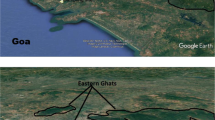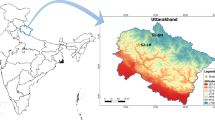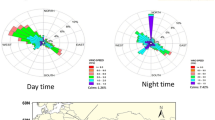Abstract
A 10-months long monitoring experiment to investigate the diurnal and seasonal variation of aerosol size distribution at Nagarkot (1,900 m asl) in the Kathmadu Valley was carried out as part of a study on katabatic and anabatic influence on pollution dispersion mechanisms. Seasonal means show total aerosol number concentration was highest during post-monsoon season (775 ± 417 cm−3) followed by pre-monsoon (644 ± 429 cm−3) and monsoon (293 ± 205 cm−3) periods. Fine particle concentration (0.25 μm ≤ DP ≤ 2.5 μm) dominated in all seasons, however, contribution by coarse particles (3.0 μm ≤ DP ≤ 10.0 μm) is more significant in the monsoon season with contributions from particles larger than 10.0 μm being negligible. Our results show a regular diurnal pattern of aerosol concentration in the valley with a morning and an evening peak. The daily twin peaks are attributed to calm conditions followed by transitional growth and break down of the valley boundary layer below. The peaks are generally associated with enhancement of the coarse particle fraction. The evening peak is generally higher than the morning peak, and is caused by fresh evening pollution from the valley associated with increased local activities coupled with recirculation of these trapped pollutants. Relatively clean air masses from neighbouring valleys contribute to the smaller morning peak. Gap flows through the western passes of the Kathmandu Valley, which sweep away the valley pollutants towards the eastern passes modulated by the mountain - valley wind system, are mainly responsible for the dominant pollutant circulation patterns exhibited within the valley.
Similar content being viewed by others
References
ADB/ICIMOD, 2006: Environment Assessment of Nepal: Emerging Issues and Challenges. Asian Development Bank / International Centre for Integrated Mountain Development (ICIMOD), 225 pp.
Akimoto, H., 2003: Global air quality and pollution. Science, 302, 1716–1719.
Alford, D., 1992: Hydrological Aspects of the Himalayan Region. ICIMOD, 81 pp.
Aryal, R. K., B.-K. Lee, R. Karki, A. Gurung, J. Kandasamy, B. K. Pathak, S. Sharma, and N. Giri, 2008: Seasonal PM10 dynamics in Kathmandu Valley. Atmos. Environ., 42, 8623–8633.
Beniston, M., 1987: A numerical study of atmospheric pollution over complex terrain in Switzerland. Bound-Lay. Meteorol., 41, 75–96.
Brulfert, G., C. Chemel, E. Chaxel, J. P. Chollet, B. Jouve, and H. Villard, 2006: Assessment of 2010 air quality in two Alpine valleys from modelling: Weather type and emission scenarios. Atmos. Environ., 40, 7893–7907.
Carrico, C. M., M. H. Bergin, A. B. Shrestha, J. E. Dibb, L. Gomes, and J. M. Harris, 2003: The importance of carbon and mineral dust to seasonal aerosol properties in the Nepal Himalaya. Atmos. Environ., 37, 2811–2824.
Deshmukh, D. K., and M. K. Deb, 2013: Size distribution and seasonal variation of size-segregated particulate matter in the ambient air of Raipur city, India. Air Qual. Atmos. Health, 6, 259–276.
Gautam, R., and Coauthors, 2011: Accumulation of aerosols over the Indo- Gangetic plains and southern slopes of the Himalayas: distribution, properties and radiative effects during the 2009 pre-monsoon season. Atmos. Chem. Phy., 11, 12841–12863.
Grigoras, G., V. Cuculeanu, G. Ene, G. Mocioaca, and A. Deneanu, 2012: Air pollution dispersion modeling in a polluted industrial area of complex terrain from Romania. Rom. Rep. Phys., 64, 173–186.
Guo, J., S. Kang, J. Huang, Q. Zhang, L. Tripathee, and M. Sillanpaa, 2015: Seasonal variations of trace elements in precipitation at the largest city in Tibet, Lhasa. Atmos. Res., 153, 87–97.
Gurung, A., and M. L. Bell, 2013: The state of scientific evidence on air pollution and human helath in Nepal. Environ. Res., 124, 54–64.
Hindman, E. E., and B. P. Upadhayay, 2002: Air pollution transport in the Himalayas of Nepal and Tibet during the 1995-1996 dry season. Atmos. Environ., 36, 727–739.
Kajino, M., W. Winiwarter, and H. Ueda, 2006: Modeling retained water concent in measured aerosol mass. Atmos. Environ., 40, 5202–5213.
Kan, H., and B. Chen, 2004: Particulate air pollution in urban areas of Shanghai, China: health-based economic assessment. Sci. Total Environ., 322, 71–79.
Kim, D., and W. R. Stockwell, 2007: An online coupled meteorological and air quality modeling study of the effect of complex terrain on the regional transport and transformation of air pollutants over the Western United States. Atmos. Environ., 41, 2319–2334.
Liao, J., T. Wang, Z. Jiang, B. Zhuang, M. Xie, C. Yin, X. Wang, J. Zhu, Y. Fu, and Y. Zhang, 2015: WRF/Chem modeling of the impacts of urban expansion on regional climate and air pollutants in Yangtze Delta, China. Atmos. Environ., 106, 204–214.
Marinoni, A., and Coauthors, 2010: Aerosol mass and black carbon concentration, a two year record at NCO-P (5079 m, Southern Himalayas). Atmos. Chem. Phy., 10, 8551–8562.
Martilli, A., and D. G. Steyn, 2004: A Numerical Study of Recirculation Processes in the Lower Fraser Valley (British Columbia, Canada). Air Pollution Modelling and Its Application XVII, Banff, 727 pp.
Miao, Y., S. Liu, Y. Zheng, S. Wang, and B. Chen, 2015: Numerical study of the effects of topography and urbanization on the local atmospheric circulations over the Beijing-Tianjin-Hebei, China. Adv. Meteorol., 2015, http://dx.doi.org/10.1155/2015/397070.
Min, H., J. Jing, and W. Zhijun, 2005: Chemical compositions of precipitation and scavenging of particles in Beijing. Sci. China Ser. B., 48, 265–272.
Nakajima, C., 1976: Movement and development of the clouds over Khumbu Himal in winter. Seppyo, 38, 89–92.
Panday, A. K., 2006: The Diurnal Cycle of Air Pollution in the Kathmandu Valley, Nepal. Ph.D. Thesis, Center for Global Change Science, Massachusetts Institute of Technology, 234 pp.
Panday, A. K., and R. G. Prinn, 2009: Diurnal cycle of air pollution in the Kathmandu Valley, Nepal: Observations. J. Geophys. Res., 114.
Panday, A. K., R. G. Prinn, and C. Schar, 2009: Diurnal cycle of air pollution in the Kathmandu Valley, Nepal: 2. Modeling results. J. Geophys. Res., 114.
Putero, D., and Coauthors, 2015: Seasonal variation of ozone and black carbon observed at Pakanjol, an urban site in the Kathmandu Valley, Nepal. Atmos. Chem. Phy. Discuss., 15, 22527–22566.
Radke, L. F., P. V. Hobbs, and M. W. Eltgroth, 1980: Scavenging of Aerosol particles by precipitation. J. Appl. Meteor., 19, 715–722.
Regmi, R. P., T. Kitada, and G. Kurata, 2002: Numerical Simulation of Late Wintertime Local Flows in Kathmandu Valley, Nepal: Implication for Air Pollution Transport. J. Appl. Meteor., 42, 389–403.
Reid, J. D., 1978: Studies of pollutant transport and turbulent dispersion over rugged Mountainous terrain near Climax, Colorado. Atmos. Env., 13, 23–28.
Saha, A., and K. K. Moorthy, 2004: Impact of Precipitation on Aerosol Spectral Optical Depth and Retrieved Size Distributions: A Case Study. J. Appl. Meteor., 43, 902–914.
Segal, M., C.-H. Yu, and R. A. Pielke, 1988: Model Evaluation of the Impact of Thermally Induced Valley Circulation in the Lake Powell Area on Long-Range Pollutant Transport. JAPCA, 38, 163–170.
Sellegri, K., P. Laj, H. Venzac, J. Boulon, D. Picard, P. Villani, P. Bonasoni, A. Marinoni, P. Cristofanelli, and E. Vuillermmoz, 2010: Seasonal variations of aerosol size distributions based on long-term measurements at the high altitude Himalayan site of Nepal Climate Observatory- Pyramid (5,079 m), Nepal. Atmos. Chem. Phy., 10, 6537–6566.
Shrestha, A. B., C. P. Wake, P. A. Mayewski, and J. E. Dibb, 1999: Maximum Temperature Trends in the Himalaya and Its Vicinity: An Analysis Based on Temperature Records from Nepal for the Period 1971-94. J. Climate, 12, 2775–2786.
Shrestha, A. B., C. P. Wake, J. E. Dibb, P. A. Mayewski, S. I. Whitlow, G. R. Carmichael, and M. Ferm, 2000: Seasonal variations in aerosol concentrations and compositions in the Nepal Himalaya. Atmos. Environ., 34, 3349.
Shrestha, A. B., C. P. Wake, J. E. Dibb, and S. I. Whitlow, 2002: Aerosol and Precipitation Chemistry at a Remote Himalayan Site in Nepal. Aerosol Sci. Technol., 36, 441–456.
Shrestha, M. L., 2000: Interannual variation of summer monsoon rainfall over Nepal and its relation to Southern Oscillation Index. Meteorol. Atmos. Phys., 75, 21–28.
Shrestha, P., and A. P. Barros, 2010: Joint spatial variability of aerosol, clouds and rainfall in the Himalayas from satellite data. Atmos. Chem. Phy., 10, 8305–8317.
Shrestha, P., A. P. Barros, and A. Khlystov, 2010: Chemical composition and aerosol size distribution of the middle mountain range in the Nepal Himalayas during the 2009 pre-monsoon season. Atmos. Chem. Phy., 10, 11605–11621.
Thapa, R. B., and Y. Murayama, 2011: Urban growth modeling of Kathmandu metropolitan region, Nepal. Comput. Environ. Urban Syst., 35, 25–34.
Venzac, H., and Coauthors, 2008: High frequency new particle formation in the Himalayas. Proc. Natl. Acad. Sci., 105, 15666–15671.
Whiteman, C. D., 2000: Mountain Meteorology. Oxford University Press, 355 pp.
Author information
Authors and Affiliations
Corresponding author
Rights and permissions
About this article
Cite this article
Shrestha, R.K., Gallagher, M.W. & Connolly, P.J. Diurnal and seasonal variations of meteorology and aerosol concentrations in the foothills of the nepal himalayas (Nagarkot: 1,900 m asl). Asia-Pacific J Atmos Sci 52, 63–75 (2016). https://doi.org/10.1007/s13143-016-0002-3
Received:
Accepted:
Published:
Issue Date:
DOI: https://doi.org/10.1007/s13143-016-0002-3




